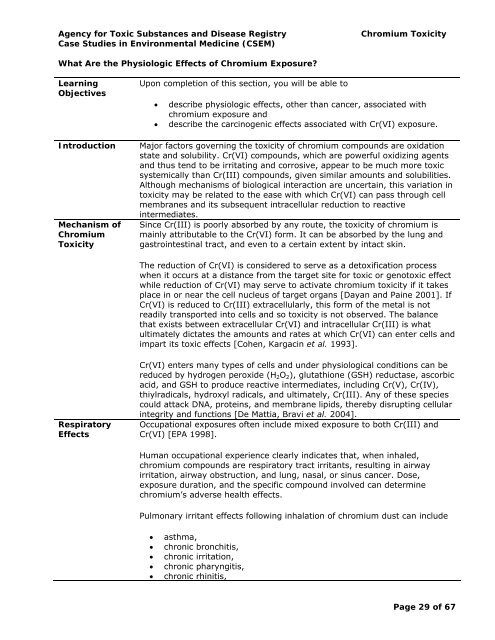(Cr) Toxicity | ATSDR - CSEM - Agency for Toxic Substances and ...
(Cr) Toxicity | ATSDR - CSEM - Agency for Toxic Substances and ...
(Cr) Toxicity | ATSDR - CSEM - Agency for Toxic Substances and ...
Create successful ePaper yourself
Turn your PDF publications into a flip-book with our unique Google optimized e-Paper software.
<strong>Agency</strong> <strong>for</strong> <strong>Toxic</strong> <strong>Substances</strong> <strong>and</strong> Disease Registry Chromium <strong><strong>Toxic</strong>ity</strong><br />
Case Studies in Environmental Medicine (<strong>CSEM</strong>)<br />
What Are the Physiologic Effects of Chromium Exposure?<br />
Learning<br />
Objectives<br />
Upon completion of this section, you will be able to<br />
• describe physiologic effects, other than cancer, associated with<br />
chromium exposure <strong>and</strong><br />
• describe the carcinogenic effects associated with <strong>Cr</strong>(VI) exposure.<br />
Introduction Major factors governing the toxicity of chromium compounds are oxidation<br />
state <strong>and</strong> solubility. <strong>Cr</strong>(VI) compounds, which are powerful oxidizing agents<br />
<strong>and</strong> thus tend to be irritating <strong>and</strong> corrosive, appear to be much more toxic<br />
systemically than <strong>Cr</strong>(III) compounds, given similar amounts <strong>and</strong> solubilities.<br />
Although mechanisms of biological interaction are uncertain, this variation in<br />
toxicity may be related to the ease with which <strong>Cr</strong>(VI) can pass through cell<br />
membranes <strong>and</strong> its subsequent intracellular reduction to reactive<br />
intermediates.<br />
Mechanism of<br />
Chromium<br />
<strong><strong>Toxic</strong>ity</strong><br />
Respiratory<br />
Effects<br />
Since <strong>Cr</strong>(III) is poorly absorbed by any route, the toxicity of chromium is<br />
mainly attributable to the <strong>Cr</strong>(VI) <strong>for</strong>m. It can be absorbed by the lung <strong>and</strong><br />
gastrointestinal tract, <strong>and</strong> even to a certain extent by intact skin.<br />
The reduction of <strong>Cr</strong>(VI) is considered to serve as a detoxification process<br />
when it occurs at a distance from the target site <strong>for</strong> toxic or genotoxic effect<br />
while reduction of <strong>Cr</strong>(VI) may serve to activate chromium toxicity if it takes<br />
place in or near the cell nucleus of target organs [Dayan <strong>and</strong> Paine 2001]. If<br />
<strong>Cr</strong>(VI) is reduced to <strong>Cr</strong>(III) extracellularly, this <strong>for</strong>m of the metal is not<br />
readily transported into cells <strong>and</strong> so toxicity is not observed. The balance<br />
that exists between extracellular <strong>Cr</strong>(VI) <strong>and</strong> intracellular <strong>Cr</strong>(III) is what<br />
ultimately dictates the amounts <strong>and</strong> rates at which <strong>Cr</strong>(VI) can enter cells <strong>and</strong><br />
impart its toxic effects [Cohen, Kargacin et al. 1993].<br />
<strong>Cr</strong>(VI) enters many types of cells <strong>and</strong> under physiological conditions can be<br />
reduced by hydrogen peroxide (H2O2), glutathione (GSH) reductase, ascorbic<br />
acid, <strong>and</strong> GSH to produce reactive intermediates, including <strong>Cr</strong>(V), <strong>Cr</strong>(IV),<br />
thiylradicals, hydroxyl radicals, <strong>and</strong> ultimately, <strong>Cr</strong>(III). Any of these species<br />
could attack DNA, proteins, <strong>and</strong> membrane lipids, thereby disrupting cellular<br />
integrity <strong>and</strong> functions [De Mattia, Bravi et al. 2004].<br />
Occupational exposures often include mixed exposure to both <strong>Cr</strong>(III) <strong>and</strong><br />
<strong>Cr</strong>(VI) [EPA 1998].<br />
Human occupational experience clearly indicates that, when inhaled,<br />
chromium compounds are respiratory tract irritants, resulting in airway<br />
irritation, airway obstruction, <strong>and</strong> lung, nasal, or sinus cancer. Dose,<br />
exposure duration, <strong>and</strong> the specific compound involved can determine<br />
chromium’s adverse health effects.<br />
Pulmonary irritant effects following inhalation of chromium dust can include<br />
• asthma,<br />
• chronic bronchitis,<br />
• chronic irritation,<br />
• chronic pharyngitis,<br />
• chronic rhinitis,<br />
Page 29 of 67

















